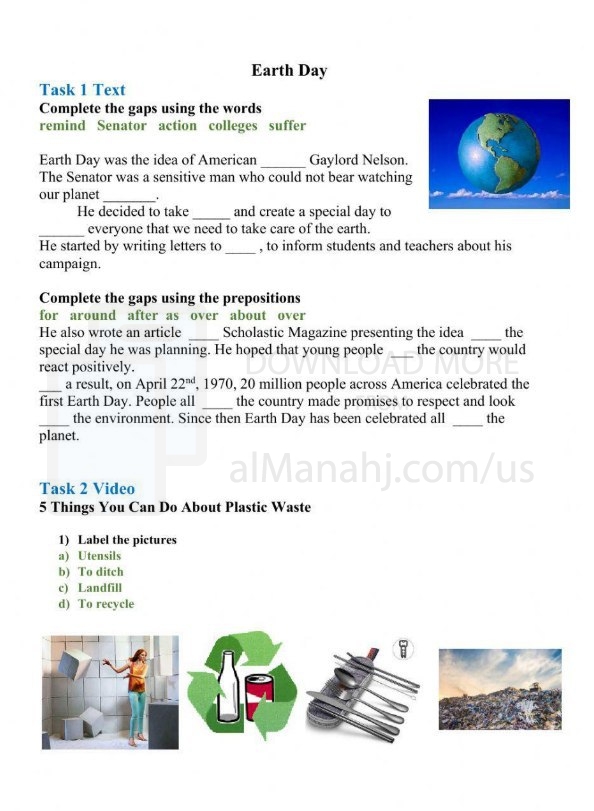| You are here: Almanahj Website ⇒ American curriculum ⇒ 10th Grade ⇒ Geology ⇒ Term 1 | ||
|---|---|---|
Worksheet about history of the Earth day | ||
|---|---|---|
| Subject: Geology | ||
| 10th Grade | ||
| Term 1 | ||
| Year: 2023/2024 | ||
| Size: 638.4KB | ||
| Number of clicks: 144 | ||
| Publish date:November 27, 2023 | ||
| Added by: Eman | ||
| Last download date: 2024-08-28 09:42:36 | By: theodor Ksana Kovalenko | |
| File info: The history of Earth Day dates back to the environmental movement of the 1960s, which was a response to growing concerns about pollution, environmental degradation, and the need for conservation. Here's a timeline of the key events that led to the establishment of Earth Day: 1. Silent Spring (1962): The publication of Rachel Carson's book "Silent Spring" in 1962 brought widespread attention to the adverse effects of pesticides and their impact on the environment. The book raised public awareness about pollution and its consequences for ecosystems and human health. 2. Santa Barbara Oil Spill (1969): In January 1969, a massive oil spill occurred off the coast of Santa Barbara, California. The spill resulted in significant ecological damage and galvanized public outrage. It was a catalyst for the environmental movement and inspired calls for more significant action to protect the environment. 3. Teach-In on the Environment (1969): Inspired by the anti-war teach-ins of the time, Senator Gaylord Nelson, a U.S. Senator from Wisconsin, envisioned a nationwide teach-in to educate the public about environmental issues. He announced his idea for a "national environmental teach-in" in a speech in Seattle in September 1969. 4. Earth Day (1970): On April 22, 1970, the first Earth Day took place. It was organized as a grassroots movement across the United States, involving millions of people who demonstrated, participated in environmental events, and engaged in educational activities. Earth Day helped to bring environmental concerns to the forefront of public consciousness and generated widespread public support for environmental protection. 5. Environmental Protection Agency (EPA) and Environmental Legislation: The success of Earth Day and the growing public concern for the environment led to the establishment of the United States Environmental Protection Agency (EPA) in December 1970. The EPA was tasked with protecting human health and the environment through the implementation and enforcement of environmental laws. Additionally, the 1970s saw the passage of several landmark environmental laws, including the Clean Air Act, the Clean Water Act, and the Endangered Species Act. 6. Global Expansion: Earth Day went global in 1990, with events organized in various countries around the world. The international focus helped to raise awareness about global environmental issues and fostered increased cooperation and action on a global scale. 7. Continuing Impact: Earth Day continues to be observed annually on April 22nd, with millions of people participating in activities to promote environmental awareness and sustainability. It serves as a reminder of the ongoing need for environmental protection and conservation efforts. Earth Day has played a significant role in raising environmental awareness, mobilizing public support, and shaping environmental policy. It has been instrumental in driving positive change and inspiring individuals, communities, and governments to take action to protect the environment and promote sustainability. | ||
| Downloading link Worksheet about history of the Earth day |
|---|
|
1701071285.pdf
The file is being prepared for download
|
| File images |
|---|
 |